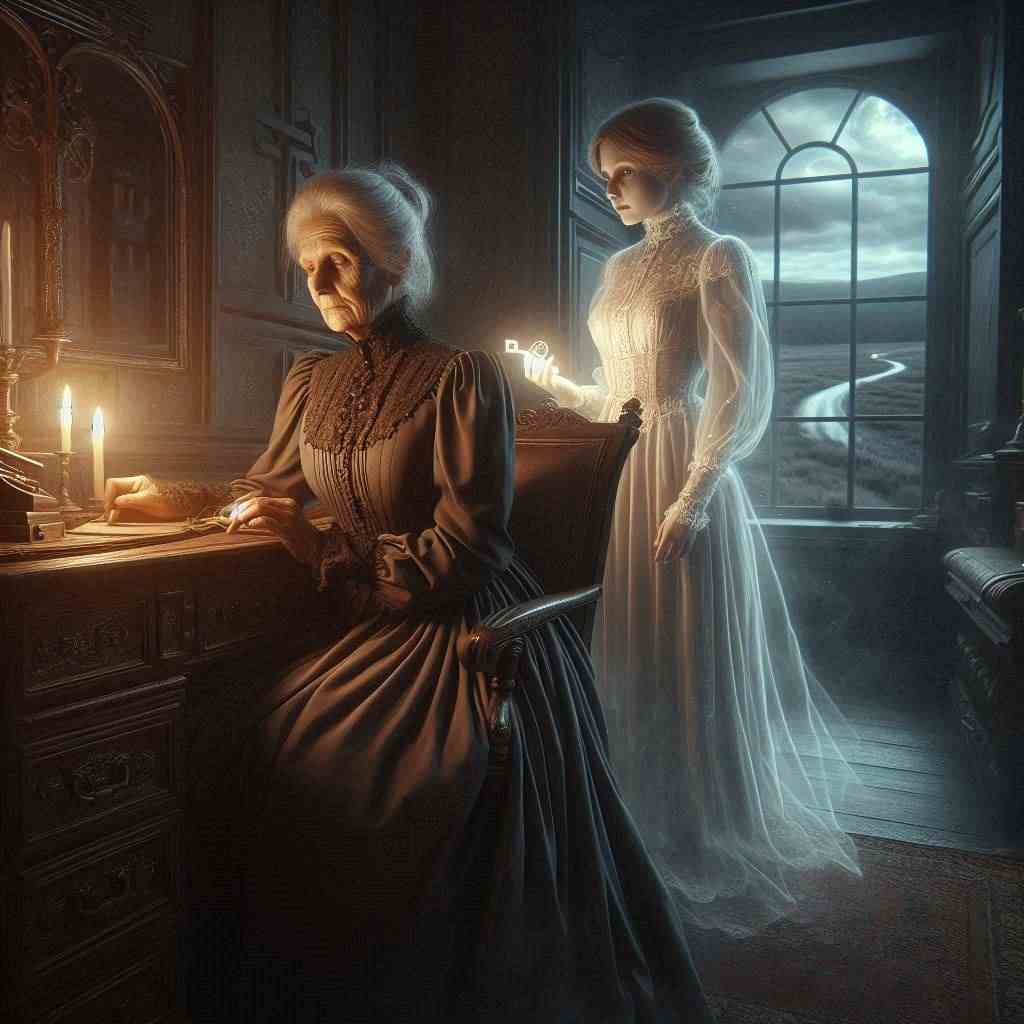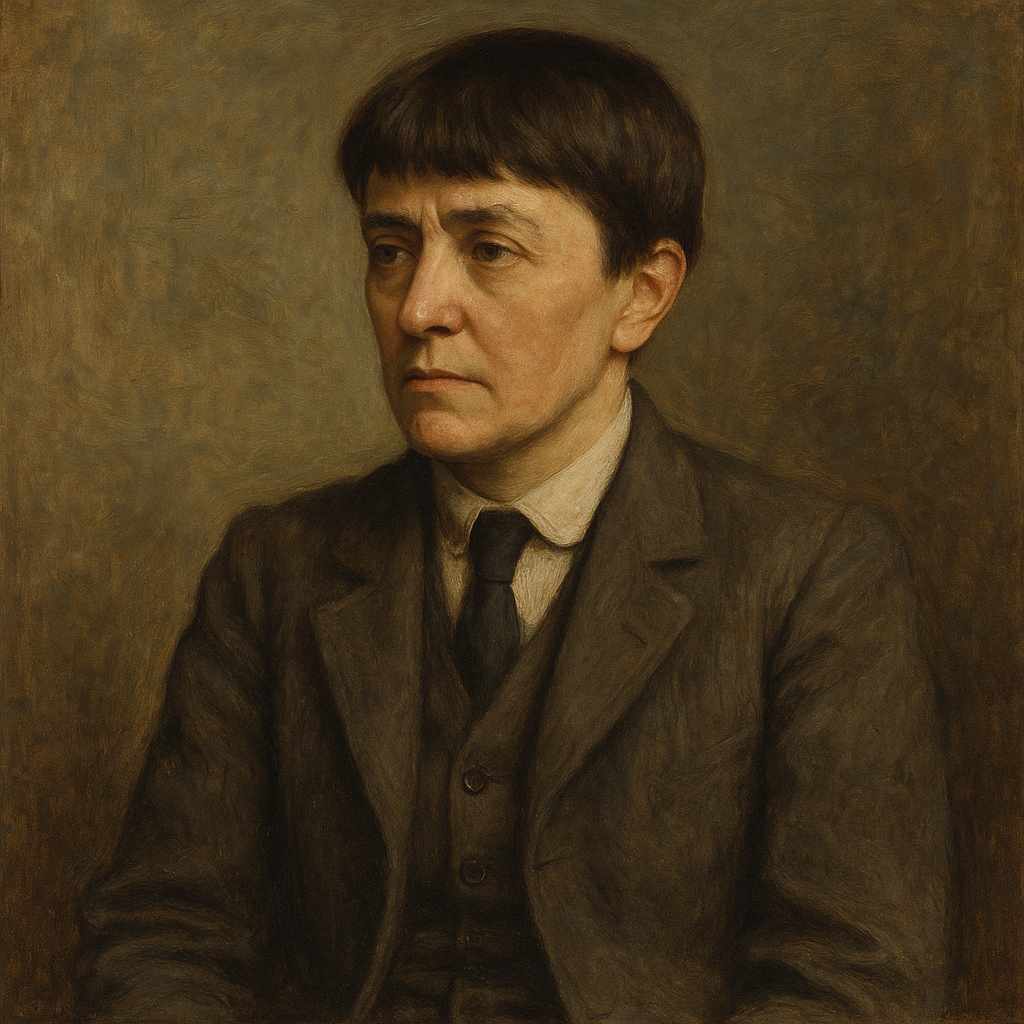The Peddler
Charlotte Mew
1869 to 1928

Lend me, a little while, the key
That locks your heavy heart, and I’ll give you back—
Rarer than books and ribbons and beads bright to see,
This little Key of Dreams out of my pack.
The road, the road, beyond men’s bolted doors,
There shall I walk and you go free of me,
For yours lies North across the moors,
And mine lies South. To what seas?
How if we stopped and let our solemn selves go by,
While my gay ghost caught and kissed yours, as ghosts don’t do,
And by the wayside, this forgotten you and I
Sat, and were twenty-two?
Give me the key that locks your tired eyes,
And I will lend you this one from my pack,
Brighter than colored beads and painted books that make men wise:
Take it. No, give it back!
Charlotte Mew's The Peddler
Introduction
Charlotte Mew's poem "The Peddler" is a haunting exploration of the human condition, weaving together themes of longing, nostalgia, and the ephemeral nature of human connections. This deceptively simple sixteen-line poem, published in 1916, showcases Mew's mastery of form and her ability to evoke profound emotions through carefully crafted imagery and metaphor. In this analysis, we will delve into the various layers of meaning within the poem, examining its structure, literary devices, and thematic implications to uncover the depth of Mew's artistry.
Structure and Form
The poem is structured in four quatrains, each following an ABAB rhyme scheme. This regular form provides a sense of stability and rhythm, which contrasts intriguingly with the poem's themes of transience and emotional flux. The alternating rhymes create a musical quality that echoes the peddler's wandering nature and the back-and-forth exchange proposed in the poem.
Mew's use of enjambment is particularly noteworthy, as it allows the thoughts to flow seamlessly from one line to the next, mirroring the continuous movement of the peddler and the fluid nature of memory and emotion. This technique is especially evident in lines such as "Rarer than books and ribbons and beads bright to see, / This little Key of Dreams out of my pack."
Imagery and Symbolism
Central to the poem is the extended metaphor of the "key" and the "heart." The speaker, presumably the peddler, offers to exchange a "little Key of Dreams" for the key that "locks your heavy heart." This imagery suggests that the peddler possesses the ability to unlock imagination and fantasy, while the addressee holds the key to genuine emotional experience.
The symbolism of the key is multifaceted. It represents access to hidden or suppressed aspects of the self, the power to reveal or conceal emotions, and the potential for transformation. The contrast between the "heavy heart" and the "Key of Dreams" underscores the tension between reality and fantasy, burden and liberation.
The road serves as another powerful symbol, representing life's journey and the divergent paths individuals take. The lines "For yours lies North across the moors, / And mine lies South. To what seas?" eloquently capture the sense of separation and unknown destinies that often characterize human relationships.
Themes
Transience and Nostalgia
A pervasive theme in "The Peddler" is the fleeting nature of human connections and experiences. The poem suggests a brief encounter between the speaker and the addressee, hinting at a deeper connection that cannot be fully realized due to the constraints of time and circumstance. This sense of transience is poignantly expressed in the third stanza:
"How if we stopped and let our solemn selves go by, While my gay ghost caught and kissed yours, as ghosts don't do, And by the wayside, this forgotten you and I Sat, and were twenty-two?"
Here, Mew brilliantly juxtaposes the "solemn selves" with the playful, youthful "ghosts," creating a stark contrast between present reality and past possibility. The specific age mentioned, twenty-two, evokes a sense of nostalgia for youth and its associated freedom and potential.
The Duality of Human Nature
Mew explores the complexity of human nature through the contrasting images and emotions presented in the poem. The peddler embodies both the allure of fantasy and the wisdom of experience, offering "colored beads and painted books that make men wise." This duality is further emphasized by the tension between the desire to escape into dreams and the need to confront reality.
The poem also touches on the divide between public and private selves, as suggested by the reference to "men's bolted doors" and the exchange of keys that unlock hidden aspects of the self. This exploration of inner and outer worlds reflects the modernist preoccupation with the fragmented nature of human identity.
The Power and Limitations of Imagination
The "Key of Dreams" offered by the peddler represents the transformative power of imagination. It is presented as something "Rarer than books and ribbons and beads bright to see," suggesting its value surpasses material possessions. However, the poem also acknowledges the limitations of fantasy, as evidenced by the final line: "Take it. No, give it back!" This abrupt reversal implies that while imagination can provide temporary solace, it cannot ultimately replace genuine emotional connection or alter the course of one's life journey.
Literary Devices
Mew employs a range of literary devices to enhance the poem's emotional impact and complexity:
- Alliteration: "books and beads bright," "bolted doors," emphasizing key images and creating a musical quality.
- Personification: The heart is described as being "locked," giving it human-like qualities.
- Oxymoron: "gay ghost," juxtaposing joy with the ethereal nature of spirits.
- Rhetorical question: "To what seas?" underscoring the uncertainty of life's journey.
- Paradox: "as ghosts don't do," highlighting the impossibility of the imagined scenario.
These devices work in concert to create a rich, multilayered text that rewards close reading and analysis.
Historical and Literary Context
Charlotte Mew, often overlooked in discussions of modernist poetry, demonstrates in "The Peddler" her ability to blend traditional form with modern sensibilities. Writing in the early 20th century, Mew was contemporary with poets like T.S. Eliot and Ezra Pound, who were revolutionizing poetic form. While Mew's work adheres more closely to traditional structures, her exploration of psychological complexity and the fragmentation of identity aligns her with modernist concerns.
The poem's themes of transience and the limitations of human connection resonate with the post-World War I zeitgeist, reflecting a world grappling with profound loss and disillusionment. The peddler figure, offering dreams and wisdom, can be seen as a response to this cultural moment, presenting both an escape from and a means of understanding a rapidly changing world.
Conclusion
"The Peddler" by Charlotte Mew is a masterful exploration of human longing, the intersection of past and present, and the complex relationship between reality and imagination. Through its careful structure, evocative imagery, and nuanced themes, the poem invites readers to contemplate the ephemeral nature of human connections and the role of fantasy in navigating life's journey.
Mew's ability to distill profound emotional and philosophical concepts into a concise, lyrical form demonstrates her significant, if often underappreciated, contribution to early 20th-century poetry. "The Peddler" stands as a testament to Mew's artistic vision, offering readers a deeply moving meditation on the human experience that continues to resonate more than a century after its creation.
In its exploration of the tension between reality and dreams, the poem ultimately suggests that while imagination and memory can offer solace and insight, they cannot substitute for lived experience and genuine human connection. The peddler's final retraction of the offered key serves as a poignant reminder of the inescapable nature of our individual journeys and the bittersweet reality of paths not taken.
This text was generated by AI and is for reference only. Learn more
Want to join the discussion? Reopen or create a unique username to comment. No personal details required!



Comments
No comments yet. Be the first to comment!